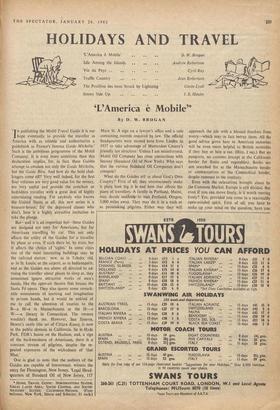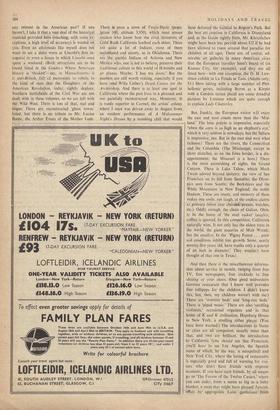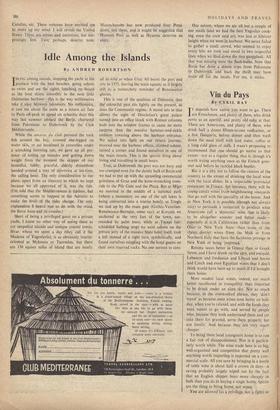HOLIDAYS AND TRAVEL
`L'America 6 Mobile' • • Idle Among the Islands • • • • Vin du Pays .. • •
Truffle Country •.
The Postilion has been Struck by Lightning Seamy Side Up
D. W. Brogan Andrew Robertson Cyril Ray Jean Robertson Gavin Lyall I. E. Hinder
`L'America è 1Vtobi1e"
By 1). W. BROGAN
IN pUbliShin the Mobil Travel Guide it is our hope eventually to provide the traveller in America with as reliable and authoritative a guidebook as France's famous Guide Michelin.' Such is the ambitious programme of the Mobil Company. It is even more ambitious than this declaration implies, for, in fact, these Guides attempt to emulate not only the Guide Michelin, but the Guide 'Bleu. And how do the bold chal- lcngers come off? Very well indeed, for the first four volumes are very good value for the money, are very useful and provide the armchair or bedridden traveller with a great deal of highly entertaining reading. For anybody who knows the United States at all, this new series is a treasure-house; for- the depressed classes who don't, here is a highly attractive invitation to take the plunge.
But—and it is an important but—these Guides are designed not only for Americans, but for Americans travelling by car. This not only affects the utility of the Guides for a traveller by plane or even, if such there be, by train, but it affects the choice of 'sights.' In some cities one of the most interesting buildings may be the railroad station: new, as in Toledo; old, a% in St. Louis; or the airport, as in Indianapolis; and as the Guides are above all directed to ad- vising the traveller about places to sleep at. they sometimes ign.ore attractive works of men's hands, like the open-air theatre that houses the Santa F6 opera. They also ignore some remark- able monuments of learning and imagination in private hands, but it would be unkind of me to call the attention of tourists to the B---a M--e in Massachusetts or the
W e library in Connecticut. The owners wouldn't thank me. However, San Simeon, Hearst's castle (the set of Citizen Kane), is now in the public domain in California. Sp is Hyde Park, FOR's house on the Hudson, and, a sign of the backwardness of Americans, there is a constant stream of pilgrims, despite the re- peated exposures of the wickedness of 'that Man.'
One is glad to note that the authors of the Guides are capable of irreverence; witness the entry for Flemington, New Jersey. 'Legal Head- quarters of Standard Oil of New Jersey, 117
* MEIRIL TRAVEL GUIDE NORTHEASTERN STATES; GREAT LAKES AREA; SOUTH CENTRAL AND SOUTH- WESTERN STATES; CALIFORNIA-NEVADA. (Four Volumes, New York, Simon and Schuster, $1 each.)
Main St. A sign on a lawyer's office and a safe containing records required by law. The official headquarters were moved here from Linden in 1937 to take advantage of Hunterdon County's friendly tax structure.' Unless I am misinformed, -Mobil Oil Company has close connections with Socony (Standard Oil of New York). Who says that the various Standard Oil Companies don't compete!
What do the Guides tell us about God's Own Country? First of all, they unconsciously make it plain how big it is and how that affects the plans of travellers. A family in Portland, Maine, may decide suddenty to visit Portland, Oregon, 3,000 miles away. They may do it in a rush or as painstaking pilgrims. Either way they will approach the job with a blessed freedom from worry—which may in fact betray them. All the good advice given here to American motorists will be even more helpful to British motorists if they buy or hire a car. (Hire, I say.) But no passports, no customs (except at the California border for fruits and vegetables). Books are not searched for at the Massachusetts border or contraceptives at the Connecticut border, despite rumours to the Contrary.
Even with the relaxations brought about by the Common Market, Europe is still divided. But even if you can move freely, is it worth moving freely? Yes; provided you come in a reasonably open-minded spirit. First of all, you have to make up your mind on the question, have you
any interest in the American past? If you haven't, I take it that a vast deal of the historical material provided here (reaching, with some ex- ceptions, a high level of accuracy) is wasted On you. Even an aficionado like myself does not want to see a dress worn at Lincoln's first in- augural or even a house in which Lincoln once spent a weekend. (Both attractions are to be found listed in the' Guides.) Where American history is thickest'—say, in Massachusetts--it is anti-British, full cd memorials to ,rebels, to the kind of men that the Daughters of the American Revolution, today, rightly deplore. Southern battlefields of the Civil War are not dealt with in these volumes, so we are left with the Wild West. There is lots of that, real and bogus. There are reconstructed 'ghost towns' listed, but there is no tribute to Mr. Lucius Beebe, the Arthur Evans of the Mother Lode. There is even a town of Twain-Harte (popu- lation 100, altitude 3,950), which must amuse readers Who know how the rival inventors. of Gold Rush California loathed each other. There are quite a lot of Indians, most of them assimilated and snooty, as in Oklahoma. There are the pueblo Indians of Arizona and New Mexico who, one is led to believe, preserve their fraditional culture in this world of H-bombs and jet planes. Maybe; 'I hae ma doots.' But the pueblos are still worth visiting, especially if you have read Willa Cather's Death Comes for the Archbishop. And there is at least one spot in California where the past lives in a pleasant and not painfully reconstructed way, Monterey. It is vastly superior to Carmel, the artists' colony where I once was driven away in August from an outdoor performance of A Midsummer Night's Dream by a numbing chill that would have defeated the faithful in Regent's Park. But the best art creation in 'California is Disneyland and, as the Guide rightly hints, Mr. Khrushchev might have been less peevish about U2 if he had been allowed to roam around that paradise for children of all ages. There are, of course, ad- mirable art galleries in many American cities that the European traveller hasn't heard of (in Kansas City, for example), and they are all listed here—with one exception, the D. H. Law- rence exhibit in La Fonda at Taos. (Adults only; SI.) Here (along with a large number of Phil- hellenic prints, including Byron as a Klepht with a Gordon tartan plaid) are some dreadful *titres by Lorenzo which are quite enough to explain Lady Chatterley.
But, frankly, the European visitor will enjoy the east and west coasts more than the 'Mid- land.' The lone prairie is impressive, especially 'when the corn is as high as an elephant's eye,' which it very seldom is nowadays, but the Sahara is impressive, too. But in the east and west what richness! There are the rivers, the Connecticut and the Columbia. (The Mississippi, except in short stretches, as on the Iowa border, is a dis- appointment; the Missouri is a bore.) There is the most astonishing of sights, the Grand Canyon. There is Lake Tahoe, which Mark Twain adored beyond idolatry; the view of San Francisco on its hill from Sausalito; the Olym- pics seen from Seattle; the Berkshires and the White Mountains in New England; the noble Hudson. These are musts, and memory of them makes one smile, not laugh, at the endless claims to primacy (thost'sour cherzieii, prunes, watches, etc.). Oddly enough, the claim of Galion, Ohio, to be the home of 'the steel casket' (anglice, coffin) is ignored. In this competition, California naturally wins. It not only has the oldest trees in the world, the giant sequoias of Muir Woods, but the smallest. In the 'Pigmy Forest . . . poor soil conditions inhibit tree growth. Some, nearly seventy-five years old, have trunks only a quarter of an inch in diameter.' They wouldn't have thought of that one in Texas!
And then there is the miscellaneous informa- tion about service in motels, ranging from free TV, free newspapers, free cocktails to free shining of your shoes. (One good midwestern German restaurant that I know well provides free lollipops for the children. I didn't know this, but, then, my children weren't with me.) There are 'oversize beds' and ling-size beds.' There is 'piped music.' There are also 'strolling violinists,' occasional organists and in that home of K und K civilisation, Hapsburg House in New York, a strolling zither player. (You have been warned.) The introductions to States or cities are all competent, usually more than that, and two are brilliant, the introduction to California (you should see San Francisco, you'll have to see Los Angeles, the Spanish name of which, by the way, is misspelled) and New York City, where the listing of restaurants is especially good and full of warning for visi- tors who don't have friends with expense accounts. If you have such friends, by all means go to 'The Forum of the Twelve Cwsars,' where you can order, from a menu as big as a baby blanket, a meal that might have pleased Apicius, Offset by appropriate Latin quotations from Catullus, etc, These volumes have enabled me to make up my mind. I will revisit the United States. There are errors and omissions, but sur- prisingly few. Two, perhaps, deserve note. Massachusetts has now produced four Presi- dent, not three, and it might be suggested that Hyannis Port as well as Hyannis deserves an entry.








































 Previous page
Previous page